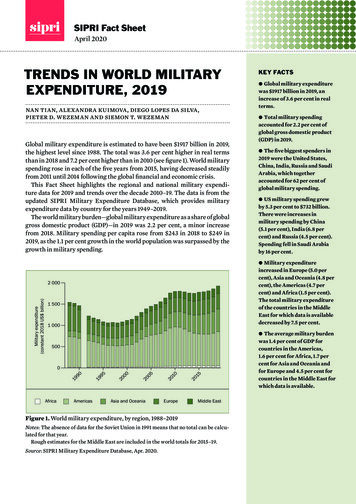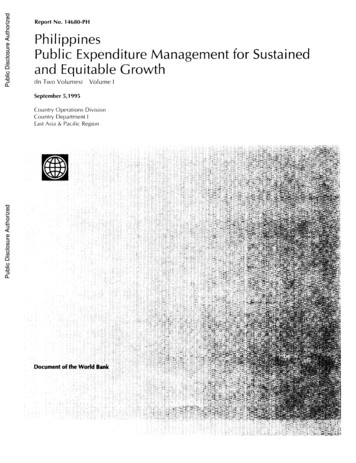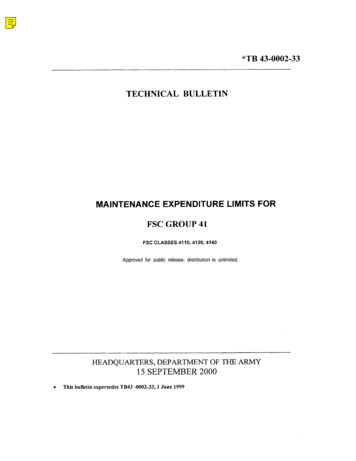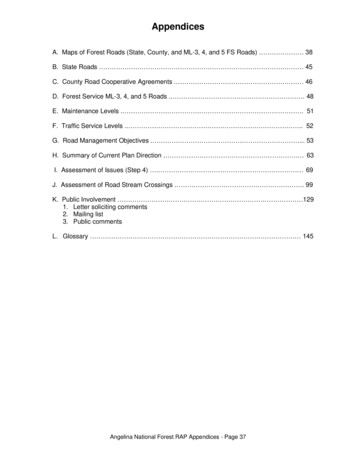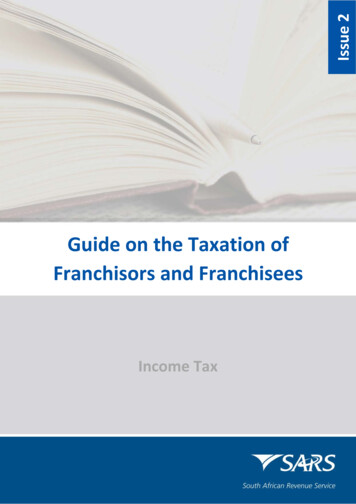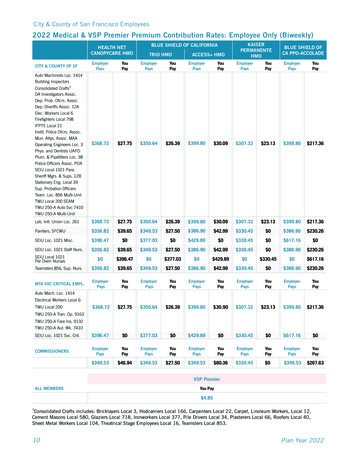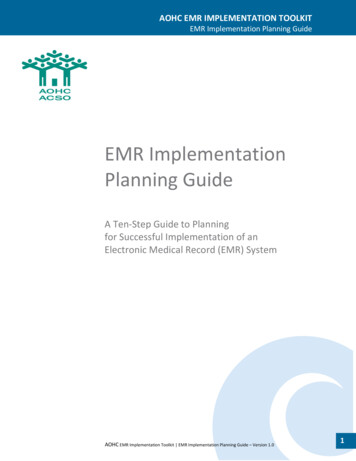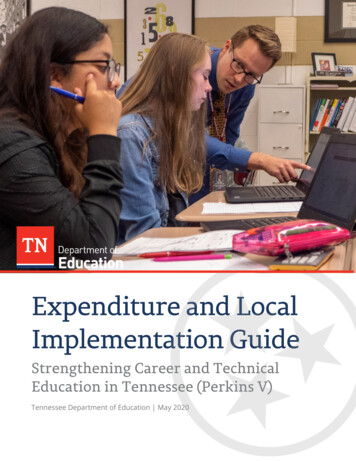
Transcription
Expenditure and LocalImplementation GuideStrengthening Career and TechnicalEducation in Tennessee (Perkins V)Tennessee Department of Education May 2020
Table of ContentsPurpose of this Guide . 2Definitions . 3Sources of Local Funding . 5Perkins Basic Allocation .5Perkins Re-allocated Funds .5Perkins Reserve Grant .5Basic Cost Principles . 6Local Uses of Funds . 6Budget Line Items . 9Allowable and Unallowable Expenditures . 11Common Allowable Expenditures . 11Unallowable Expenditures . 13Frequently Asked Questions . 14Purpose of this GuideThe purpose of this guide is to provide guidance for the expenditure of local funds available through PerkinsV. This guide provides definitions of commonly used terms, explains the types of funding available, offersguidance on basic cost principles, details local uses of funds, captures budget line items, overviewsallowable and unallowable expenditures, and answers frequently asked questions.If you have any questions using this guide, please contact your CORE CTE Consultant and/orCTE.Questions@tn.gov.2 May 2020
DefinitionsCTE Program of Study (POS)The term CTE Program of Study (POS) is defined in the Act as, “a coordinated, nonduplicative sequence ofacademic and technical content and the secondary and postsecondary level that, incorporates challengingState academic standards; addresses both academic and technical knowledge and skills, includingemployability skills; is aligned with the needs of industries in the economy of the State, region, tribalcommunity, or local area; progresses in specificity (beginning with all aspects of an industry or career clusterand leading to more occupation-specific instruction); has multiple entry and exit points that incorporatecredentialing; and culminates in the attainment of a recognized postsecondary credential.”In Tennessee, secondary programs of study are defined by the department or submitted as a specialprogram of study and approved by the Tennessee State Board of Education.Eligible RecipientThe term Eligible Recipient is defined as, (A) a local educational agency (LEA) or a consortium of LEAs, anarea career and technical education center, an educational service agency, an Indian Tribe or Tribalorganization or Tribal educational agency; or (B) an eligible institution or consortium of institutions, whichmeet the eligibility requirements necessary to receive assistance as outlined in the Act.In addition to these, an eligible recipient must offer at least two full compliant programs of study or careerpathways for students to obtain concentrator status and adhere to all assurances as outlined in the localapplication.Limited jurisdiction agencies, or a LEA which does not directly serve secondary students, and individual highschools do not meet the definition of an eligible recipient. Funds made available under this Act shall bedistributed to the local educational agency or regional educational agency that provides services tosecondary school students in the same attendance area.High Skill Industry Sector or OccupationThe term high skill industry sector or occupation is defined in Tennessee as occupations which requirepostsecondary and/or long-term training such as an apprenticeship which leads to a postsecondarycredential, certificate, diploma, or degree.High Wage Industry Sector or OccupationThe term high wage industry sector or occupation is defined in Tennessee as occupations with wages 20%greater than the median regional wage to be determined using workforce development information in therespective Local Workforce Investment Area (LWIA) region.In-Demand Industry Sector or OccupationThe term in-demand industry sector or occupation is defined in Tennessee as occupations with thefollowing characteristics: The growth rate for the industry sector in the LWIA region is positive and the individual occupationshave positive growth rates. For all occupations in the industry sector, the ratio of program completers (supply) to the number ofannual average openings for the occupations (demand) is no more than 1.5.3 May 2020
Exception: If the available placement rates for program completers are 95% or above(program completers placed in jobs related to their high skill training), then the occupationsin the industry sector is considered “in demand.”The average annual number of openings in the industry sector is equal to or greater than theaverage number of openings for all regional employment.oMeaningful ProgressGrowth equal to or greater than one half (0.5) of a percent toward goals and performance targets.Size, Scope, and QualityVertically aligned programs, which are designed in collaboration with local stakeholders and evaluatedthrough strong student-focused career outcomes and meets the following indicators:1. Offer approved program(s) of study with sequenced courses of sufficient size to meet the needsidentified by the local advisory council and aligned to local and regional employment opportunities.2. Allows students to develop academically and receive adequate training to be successful in high skill, highwage, and/or in-demand opportunities.3. Ensures students have access to quality educators in the classroom and provides opportunities foreducator professional development to support their continued growth.4. Supports student and parent understanding of how personal interests, abilities, and values mightpredict success in academic and career fields and how to form goals accordingly.5. Allows students to demonstrate their college and career readiness through work-based learningexperiences, career and technical student organizations (CTSO) participation, and early postsecondarycredit attainment, including industry certification(s).Special PopulationsSpecial populations include1.2.3.4.5.6.7.individuals with disabilities;individuals from economically disadvantaged families, including low-income youth and adults;individuals preparing for nontraditional fields;single parents, including single pregnant women,out-of-workforce individuals;English learners;Homeless individual described in section 725 of the McKinney-Vento Homeless Assistance Act (42 U.S.C.11434a) ;8. youth who are in, or have aged out of, the foster care system; and9. youth with a parent whoa. is a member of the armed forcesb. is on active dutySupplement vs. Supplant“Supplement” means to “build upon” or “add to”; “supplant” means to “replace” or “take the place of.”Federal law prohibits recipients of federal funds from replacing state, local, or agency funds with federalfunds. Existing funds for a project and its activities may not be displaced by federal funds and reallocatedfor other organizational expenses. This is illegal.4 May 2020
Federal agencies encourage supplementing—that is, adding federal funds to what is available in state, local,or agency funds.Work-Based LearningThe term Work-Based Learning is defined in the Strengthening Career and Technical Education for the 21stCentury Act as, “sustained interactions with industry or community professionals in real workplace settings,to the extent practicable, or simulated environments at an educational institution that foster in-depth,firsthand engagement with the tasks required in a given career field, that are aligned to curriculum andinstruction.”In Tennessee, the term high-quality and/or capstone work-based learning builds on the federal definition todescribe an experience which aligns to the program of study or pathway, is based on student interest andaptitude, and facilitates an intentional progression toward the attainment or demonstration of theknowledge and skills necessary for postsecondary and career goals.Sources of Local FundingThe department will distribute no less than eighty-five percent (85%) of the state award to eligible recipientsas subrecipients. There are three opportunities for local education agencies to access funding through localfunds.Perkins Basic AllocationOf the amount distributed as local funds, no less than eighty-five percent (85%) will be distributed for basicprogram improvement. Distribution for basic program improvements at the secondary level are allocated toeligible recipients using the formula outlined in section 131(a) of the Act. To receive these funds, eligiblerecipients must complete and receive approval of the CTE Perkins Basic application in ePlan.Perkins Re-allocated FundsFunds not encumbered or obligated by eligible recipients by June 30 annually are reallocated to eligiblerecipients during the following fiscal year. Re-allocated funds can be distributed to eligible recipients usingthe basic allocation formula or added to the funds available through the reserve consolidated grant, whichis a competitive process.Perkins Reserve GrantOf the amount distributed as local funds, no less than fifteen percent (15%) will be distributed for topromote and foster innovation through the reserve consolidated grant. The funds are distributed through acompetitive process for the following eligible recipients: No less than thirty-four percent (34%) will be distributed for secondary No more than thirty-three percent (33%) will be distributed for secondary and postsecondaryregional collaborative initiatives No less than thirty-three percent (33%) will be distributed for postsecondary5 May 2020
Basic Cost PrinciplesIn addition to the required uses outlined in Section 135 of the Strengthening Career and Technical Educationfor the 21st Century Act (Perkins V), and any applicable information from the Strengthening Career andTechnical Education in Tennessee State Plan, all expenditures of Perkins funds must meet the basic costprinciples outlined in the Office of Management and Budget (OMB) Circulars, the most current of whichbeing 2 CFR 200 (the “Super circular”). The cost principles of 2 CFR 200 are the basic guidelines describingpermissible ways federal funds may be spent.The expenditure of Perkins funding is further regulated by the Education Department GeneralAdministrative Regulations (EDGAR). The general principles 2 CFR 200 state that for costs to be allowable,they must be: Reasonable and necessary (meaning that, for example, sound business practices were followed,and purchases were comparable to market prices);o A cost may be reasonable if the nature of the goods or services acquired and the amountinvolved reflect the action that a prudent person would have taken under the circumstancesprevailing at the time the decision to incur the cost was made. Allocable to the federal award (meaning that the federal grant program, in this case Perkins,derived a benefit in proportion to the funds charged to the program – for example if fifty percent(50%) of an instructor’s salary is paid with Perkins funds, then that instructor must spend at leastfifty percent (50%) of his or her time on a Perkins program); Legal under state and local law; Properly documented (and accounted for on a consistent basis with generally accepted accountingprinciples. Keep adequate documentation on file with the district to show a purchase is necessary,reasonable, and allocable); Consistent with the provisions of the grant program (Perkins V); and Not used for cost-sharing or matching any other grant agreement.Local Uses of Funds1General Authority – Each eligible recipient that receives funds under this part shall use such funds todevelop, coordinate, implement, or improve career and technical education programs to meet the needsidentified in the comprehensive needs assessment described in section 134(c).Requirements for uses of funds – Funds made available to eligible recipients under this part shall be usedto support career and technical education programs that are of sufficient size, scope, and quality to beeffective and that -1. provide career exploration and career development activities through an organized, systematicframework designed to aid students, including in the middle grades, before enrolling and whileparticipating in a career and technical education program, in making informed plans and decisionsabout future education and career opportunities and programs of study, which may include—a. introductory courses or activities focused on career exploration and career awareness, includingnon-traditional fields;b. readily available career and labor market information, including information on—1Strengthening Career and Technical Education for the 21st Century, Section 1356 May 2020
occupational supply and demand;ii. educational requirements;iii. other information on careers aligned to State, local, or Tribal (as applicable) economicpriorities; andiv. employment sectors;c. programs and activities related to the development of student graduation and career plans;d. career guidance and academic counselors that provide information on postsecondary educationand career options;e. any other activity that advances knowledge of career opportunities and assists students inmaking informed decisions about future education and employment goals, including nontraditional fields; orf. providing students with strong experience in, and comprehensive understanding of, all aspectsof an industry;2. provide professional development for teachers, faculty, school leaders, administrators, specializedinstructional support personnel, career guidance and academic counselors, or paraprofessionals, whichmay include—a. professional development on supporting individualized academic and career and technicaleducation instructional approaches, including the integration of academic and careerand technical education standards and curricula;b. professional development on ensuring labor market information is used to inform theprograms, guidance, and advisement offered to students, including information provided undersection 15(e)(2)(C) of the Wagner-Peyser Act (29 U.S.C. 49l–2(e)(2)(C));c. providing teachers, faculty, school leaders, administrators, specialized instructional supportpersonnel, career guidance and academic counselors, or paraprofessionals, as appropriate, withopportunities to advance knowledge, skills, and understanding of all aspects of an industry,including the latest workplace equipment, technologies, standards, and credentials;d. supporting school leaders and administrators in managing career and technical educationprograms in the schools, institutions, or local educational agencies of such school leaders oradministrators;e. supporting the implementation of strategies to improve student achievement and close gaps instudent participation and performance in career and technical education programs;f. providing teachers, faculty, specialized instructional support personnel, career guidance andacademic counselors, principals, school leaders, or paraprofessionals, as appropriate, withopportunities to advance knowledge, skills, and understanding in pedagogical practices,including, to the extent the eligible recipient determines that such evidence is reasonablyavailable, evidence-based pedagogical practices;g. training teachers, faculty, school leaders, administrators, specialized instructional supportpersonnel, career guidance and academic counselors, or paraprofessionals, as appropriate, toprovide appropriate accommodations for individuals with disabilities, and students withdisabilities who are provided accommodations under the Rehabilitation Act of 1973 (29 U.S.C.701 et seq.) or the Individuals with Disabilities Education Act;h. training teachers, faculty, specialized instructional support personnel, career guidance andacademic counselors, and paraprofessionals in frameworks to effectively teach students,including a particular focus on students with disabilities and English learners, which may includeuniversal design for learning, multi-tier systems of supports, and positive behavioralinterventions and support; ori.7 May 2020
i.training for the effective use of community spaces that provide access to tools, technology, andknowledge for learners and entrepreneurs, such as makerspaces or libraries;3. provide within career and technical education the skills necessary to pursue careers in high-skill, highwage, or in-demand industry sectors or occupations;4. support integration of academic skills into career and technical education programs and programs ofstudy to support—a. CTE participants at the secondary school level in meeting the challenging State academicstandards adopted under section 1111(b)(1) of the Elementary and Secondary Education Act of1965 by the State in which the eligible recipient is located; andb. CTE participants at the postsecondary level in achieving academic skills;5. plan and carry out elements that support the implementation of career and technical educationprograms and programs of study and that result in increasing student achievement of the locallevels of performance established under section 113, which may include—a. a curriculum aligned with the requirements for a program of study;b. sustainable relationships among education, business and industry, and other communitystakeholders, including industry or sector partnerships in the local area, where applicable, thatare designed to facilitate the process of continuously updating and aligning programs of studywith skills that are in demand in the State, regional, or local economy, and in collaboration withbusiness outreach staff in one-stop centers, as defined in section 3 of the Workforce Innovationand Opportunity Act (29 U.S.C. 3102), and other appropriate organizations, includingcommunity-based and youth-serving organizations;c. where appropriate, expanding opportunities for CTE concentrators to participate in acceleratedlearning programs (as described in section 4104(b)(3)(A)(i)(IV) of the Elementary and SecondaryEducation Act of 1965 (20 U.S.C. 7114(b)(3)(A)(i)(IV)), including dual or concurrent enrollmentprograms, early college high schools, and the development or implementation of articulationagreements as part of a career and technical education program of study;d. appropriate equipment, technology, and instructional materials (including support for libraryresources) aligned with business and industry needs, including machinery, testing equipment,tools, implements, hardware and software, and other new and emerging instructionalmaterials;e. a continuum of work-based learning opportunities, including simulated work environments;f. industry-recognized certification examinations or other assessments leading toward arecognized postsecondary credential;g. efforts to recruit and retain career and technical education program teachers, faculty, schoolleaders, administrators, specialized instructional support personnel, career guidance andacademic counselors, and paraprofessionals;h. where applicable, coordination with other education and workforce development programs andinitiatives, including career pathways and sector partnerships developed under the WorkforceInnovation and Opportunity Act (29 U.S.C. 3101 et seq.) and other Federal laws and initiativesthat provide students with transition-related services, including the Individuals with DisabilitiesEducation Act;i. expanding opportunities for students to participate in distance career and technical educationand blended learning programs;j. expanding opportunities for students to participate in competency-based education programs;k. improving career guidance and academic counseling programs that assist students in makinginformed academic and career and technical education decisions, including academic andfinancial aid counseling;8 May 2020
l.supporting the integration of employability skills into career and technical education programsand programs of study, including through family and consumer science programs;m. supporting programs and activities that increase access, student engagement, and success inscience, technology, engineering, and mathematics fields (including computer science andarchitecture) for students who are members of groups underrepresented in such subject fields;n. providing career and technical education, in a school or other educational setting, for adults orout-of-school youth to complete secondary school education or upgrade technical skills;o. supporting career and technical student organizations, including student preparation for andparticipation in technical skills competitions aligned with career and technical educationprogram standards and curricula;p. making all forms of instructional content widely available, which may include use of openeducational resources;q. supporting the integration of arts and design skills, when appropriate, into career and technicaleducation programs and programs of study;r. partnering with a qualified intermediary to improve training, the development of public-privatepartnerships, systems development, capacity-building, and scalability of the delivery of highquality career and technical education;s. support to reduce or eliminate out-of-pocket expenses for special populations participating incareer and technical education, including those participating in dual or concurrent enrollmentprograms or early college high school programs, and supporting the costs associated with fees,transportation, child care, or mobility challenges for those special populations; ort. other activities to improve career and technical education programs; and6. develop and implement evaluations of the activities carried out with funds under this part, includingevaluations necessary to complete the comprehensive needs assessment required under section134(c) and the local report required under section 113(b)(4)(B).Budget Line Items71300 Vocational Education Program71300 116TEACHER (New program/graduated phase out) add benefits71300 162CLERICAL PERSONNEL (Requires job description) add benefits71300 163EDUCATIONAL ASSISTANT SALARIES (Requires job description)71300 189OTHER SALARIES AND WAGES (Requires job description)71300 201SOCIAL SECURITY71300 204STATE RETIREMENT71300 206LIFE INSURANCE71300 207MEDICAL INSURANCE71300 208DENTAL INSURANCE71300 210UNEMPLOYMENT COMPENSATION71300 211LOCAL RETIREMENT71300 212EMPLOYER MEDICARE71300 217RETIREMENT – HYBRID STABILIZATION71300 299OTHER FRINGE BENEFITS71300 311CONTRACTS W/OTHER SCHOOLS SYSTEMS71300 336MAINTENANCE or EQUIPMENT REPAIR71300 369CONTRACTS FOR SUBSTITUTE TEACHERS - CERTIFIED9 May 2020
71300 399OTHER CONTRACTED SERVICES71300 429INSTRUCTIONAL SUPPLIES & MATERIALS (non-consumable)71300 429cINSTRUCTIONAL SUPPLIES & MATERIALS (consumable)71300 499OTHER SUPPLIES & MATERIALS (non-consumable)71300 599OTHER CHARGES71300 730CAREER AND TECHNICAL INSTRUCTION EQUIPMENT72130 Other Student Support72130 123GUIDANCE PERSONNEL (Requires job description)72130 146BUS DRIVERS (Field trips postsecondary transition-add benefits)72130 201SOCIAL SECURITY72130 204STATE RETIREMENT72130 206LIFE INSURANCE72130 207MEDICAL INSURANCE72130 208DENTAL INSURANCE72130 210UNEMPLOYMENT COMPENSATION72130 211LOCAL RETIREMENT72130 212EMPLOYER MEDICARE72130 217RETIREMENT – HYBRID STABILIZATION72130 299OTHER FRINGE BENEFITS72130 399OTHER CONTRACTED SERVICES72130 599OTHER CHARGES72130 146CBUS DRIVERS72130 355CTRAVEL (Student and Teacher CTSO travel)72130 399COTHER CONTRACTED SERVICES (CTSO BUS CHARTER)72130 189PDOTHER PD SALARIES (STIPENDS-Note add benefits above)72130 399PDOTHER CONTRACTED SERVICES (OUTSIDE PRESENTERS' PD)72130 524PDIn-Service/Staff Development72230 Support Services/Vocational Education Program72230 105CTE DIRECTOR SALARY72230 162CLERICAL PERSONNEL (For directors' benefit; Job description required)72230 201SOCIAL SECURITY72230 204STATE RETIREMENT72230 206LIFE INSURANCE72230 207MEDICAL INSURANCE72230 208DENTAL INSURANCE72230 210UNEMPLOYMENT COMPENSATION72230 211LOCAL RETIREMENT72230 212EMPLOYER MEDICARE72230 217RETIREMENT – HYBRID STABILIAZATION72230 299OTHER BENEFITS72230 355CTE DIRECTOR TRAVEL72230 499OTHER SUPPLIES AND EQUIPMENT72230 524CTE DIRECTOR INSERVICE/PD72230 599OTHER CHARGES72230 790OTHER EQUIPMENT10 May 2020
99100 Transfers Out99100 504INDIRECT COSTS99100 590TRANSFERS OUTAllowable and Unallowable ExpendituresThis is not a complete list of allowable/unallowable costs as it relates to Perkins V. The allowability ofexpenditures should be determined by considering the purpose and requirements of the StrengtheningCareer and Technical Education for the 21st Century Act, the Strengthening Career and Technical Education inTennessee State Plan, and any pertaining Federal cost guidelines (as outlined in the Uniform Grants Guidancesection of the EDGAR book). When in doubt, ask!What is allowable? Instructional materials, software and/or equipment must enhance instruction for CTEstudents to gain knowledge and skills that meet industry standards and expectations for approvedprograms and programs of study, and are also in high-wage, high-skill, or in-demand occupations.All costs must be directly tied to the CTE programs of study as outlined and approved in the CTE PerkinsBasic Grant application documents and ePlan sections.Common Allowable Expenditures71300 Vocational Education Programs (Instruction)Line ItemCommon ExpendituresNotes71300-116Teacher salaries Teacher salaries are only allowed whenimplementing a new (POS) Salary positions require a job description. Must keep PAR for each person. Must be phase out over three years:o 100% year oneo 50% year twoo 25% year three Associated benefits must be included71300-189 Teacher stipends Stipends are allowed for CTE related work Teacher externshipsabove and beyond working hours Stipends must include a detailed description ofservices If stipend is related to the administration of thegrant, will count toward 5% maximum of totalallocation for Administration Externship stipends must include a detaileddescription of deliverable or services as a resultof the externship71300-336Maintenance and Repair 5% maximum of total allocation Maintenance and repair of equipmentpurchased with Perkins is allowed71300-429Instructional resources and software Online software and site licenses11 May 2020
71300-429cConsumable items71300-499Industry certification exams71300-599 Organizational memberships andsubscriptionsCommunication costsMarketing activitiesUniforms, smocks, aprons, CTSOjackets/blazers 71300-730Equipment72130 Other Student SupportLine ItemCommon Expenditures72130-146Bus transportationBus drivers72130-146CLEA buses to CTSO events72130-189PDSubstitute teachers72130-355Travel 72130-355CContracted charter buses for CTSOeventsContracted services72130-399PDCTSO student activitiesCTSO teacher activities72130-524Conference and professionaldevelopment fees72130-599Recruitment of special populations TextbooksInstructional supplies below 100.005% maximum of total allocationCannot supplant local funding from previousyearMust be aligned and on the TDOE statepromoted list of industry certificationsMemberships must be for the organization, notindividual membershipCosts associated with the promotion andrecruitment of CTE POSNewspapers, radio, TV, social media,magazines, etc. to advertise a specific CTE POSUniforms, smocks, aprons, jackets, etc. must bekept in classroom as class setNew, updated, and rental of equipmentItems over 100Notes Costs to cover travel Benefits must be covered Can be used for field trips, industry tours,postsecondary visits Counts toward 20% maximum of totalallocation for CTSO For CTE teachers attending approved CTE travel Cannot supplant local funding from previousyear Counts toward 20% maximum of totalallocation for CTSO Transportation and lodging only allowed forstudents Registration, travel cost, lodging, and meals areallowed for CTSO advisors and teachers Counts toward 20% maximum of totalallocation for CTSO Counts toward 5% minimum of total allocationfor professional development Outside presenter professional development Counts toward 5% minimum of total allocationfor professional development Conference attendance fee, travel costs,lodging, and meals for CTE teachers Recruitment of special pops to ensure access toCTE programs12 May 2020
Reference State Determined PerformanceLevels (SDLP) for gaps among subgroups72230 Support Services/Vocational Education Program (Administration)Line ItemCommon ExpendituresNotes72230
participating in a career and technical education program, in making informed plans and decisions about future education and career opportunities and programs of study, which may include— a. introductory courses or activities focused on career exploration and career awareness, including non-traditional fields; b.
